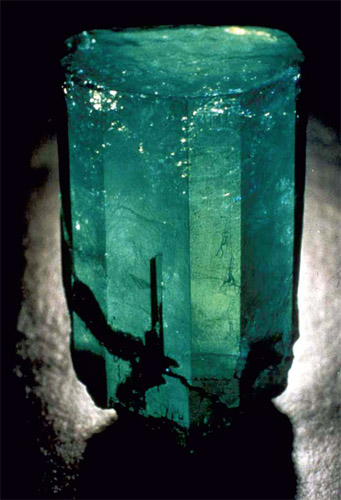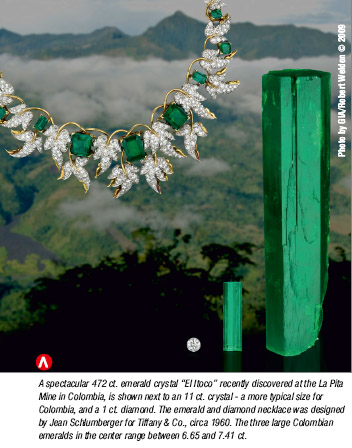

Jaipur is one of the world’s largest cutting centres for emerald, the most famous member of the beryl family. It is also home to some of the oldest gemstone businesses, some even dating back almost as far as the city’s founding in 1726. The city became an emerald processing centre in the 1920s after a major find in South Africa. Emerald’s lush green colour has soothed souls and excited imaginations since antiquity. Its name comes from the ancient Greek word for green, “smaragdus.” Rome’s Pliny the Elder described emerald in his Natural History, published in the first century AD: “…nothing greens greener” was his verdict. He described the use of emerald by early lapidaries, who “have no better method of restoring their eyes than by looking at the emerald, its soft, green color comforting and removing their weariness and lassitude.” Even today, the colour green is known to relieve stress and eye strain.
There are other green gems, like tourmaline and peridot, but emerald is the one that’s always associated with the lushest landscapes and the richest greens. Ireland is the Emerald Isle. Seattle, in the U.S. state of Washington, is the Emerald City. Thailand’s most sacred religious icon is called the Emerald Buddha, even though it’s carved from green jadeite. The first known emerald mines were in Egypt, dating from at least 330 BC into the 1700s. Cleopatra was known to have a passion for emerald, and used it in her royal adornments.
Emeralds from what is now Colombia were part of the plunder when sixteenth-century Spanish explorers invaded the New World. The Incas had already been using emeralds in their jewellery and religious ceremonies for 500 years. The Spanish, who treasured gold and silver far more than gems, traded emeralds for precious metals. Their trades opened the eyes of European and Asian royalty to emerald’s majesty. How They Form The majority of gemquality emeralds form in nature under conditions of contact metamorphism. The host rock is invaded by igneous fluids, which cause changes in the rock. A rare combination of chemically rich solutions, heat and pressure result in the formation of emeralds. The dynamic forces accompanying emerald formation frequently lead to the formation of inclusions and fissures in the crystals. Inclusions consist of small crystals of other minerals or small pockets of fluid that are “captured” within an emerald as it grows. Although an excessive amount of solid and fluid inclusions can decrease an emerald's value by reducing its transparency, the presence of a few such inclusions is desirable because they provide an important means of separating natural from synthetic emeralds.
The majority of emeralds have fractures or fissures resulting from natural forces or trauma to the crystals during mining and recovery. These are the features that emerald enhancement attempts to minimize through fracturefilling. The visibility of these fissures is often decreased through emerald clarity enhancement.
Enhancements
 A lot of new techniques of enhancements are used on emeralds to increase the value of the stones. The use of oils to enhance emeralds by reducing the appearance of fissures is a very old and widespread practice among emerald traders. The two most frequently used treatments – clarity enhancement and fracture-filling – are different ways to describe the same procedure. Clarity enhancement means improving the apparent clarity of an emerald, which is done by filling any surface-reaching fissures with an organic filler that has a refractive index similar to that of emerald. The filling process reduces the visibility of surface-reaching fissures, thus enhancing the apparent clarity of a stone. Skillful oiling, an accepted trade practice if properly disclosed, causes considerable improvement in the appearance of emeralds that contain fissures.
A lot of new techniques of enhancements are used on emeralds to increase the value of the stones. The use of oils to enhance emeralds by reducing the appearance of fissures is a very old and widespread practice among emerald traders. The two most frequently used treatments – clarity enhancement and fracture-filling – are different ways to describe the same procedure. Clarity enhancement means improving the apparent clarity of an emerald, which is done by filling any surface-reaching fissures with an organic filler that has a refractive index similar to that of emerald. The filling process reduces the visibility of surface-reaching fissures, thus enhancing the apparent clarity of a stone. Skillful oiling, an accepted trade practice if properly disclosed, causes considerable improvement in the appearance of emeralds that contain fissures.
In recent years, cedar wood oil has been preferred because its refractive index is close to that of emerald. Resins, such as Canada balsam, have also been used for enhancement. Today, commercial techniques for emerald enhancement include the use of man-made liquid resins (such as liquid Opticon), which have refractive indices closer still to that of emerald, as well as hardened or surface-hardened polymers (not all are epoxies). None of these fillers is permanent, so enhanced emeralds may require re-treatment over time.
GIA Research and Reports
The availability of extremely finequality emerald is limited, and, in the late 1990s, the popular green gemstone was plagued by negative publicity about undisclosed clarity enhancing treatments. GIA scientists have performed extensive research on the feasibility of identifying the multitude of emerald fillers available by spectroscopic techniques. Their findings have been published in Gems & Gemology over the years. The Winter 1999 article, “Classifying Emerald Clarity Enhancement at the GIA Gem Trade Laboratory,” explains the methodology the research team devised to establish the size, number and position of filled fissures and the basis to classify the apparent degree of clarity enhancement achieved. That research lead to new information on GIA’s emerald reports that indicates the degree of clarity enhancement as “minor,” “moderate” or significant.
Since emerald’s value in the marketplace can vary significantly depending on the stone’s origin and the extent to which it has been subjected to treatment, an in dependent gemmological report is highly recommended, particularly from a reputable laboratory like GIA, which has the expertise and instrumentation to determine country of origin and detect sophisticated treatments. Buyers have the right to know if a stone has been enhanced in any way. If unsure about the possibility of enhancement, the seller should either inform the buyer that the emerald is likely to have been enhanced, or obtain one of GIA’s reports, which will indicate whether or not proof of enhancement is present.
GIA’s Colored Stone Identification Reports assess the characteristics of a mounted or loose, polished or rough coloured stone (weight, measurements, shape, cutting style and colour) and indicate any detectable treatments and whether it is natural or synthetic. The report also notes whether the material is a simulant with no known natural counterpart, or if it has been assembled from two or more separate components. GIA’s Coloured Stone Origin Reports, which are available for any polished or rough, loose or mounted, natural emerald, contain all of the same information as the GIA Identification Report with the added determination of the geographic origin, when it is possible to establish.
How to Care for Them
Emerald is 7.5 to 8 on the Mohs scale of mineral hardness and has fair to good toughness, making it a stone that requires more care in wearing than ruby or sapphire. Even so, emeralds are beautiful stones for all types of jewellery and with proper care will last for generations. Heat can damage emeralds, especially by extending existing fractures. Light and chemicals can cause the oils, resins, and polymers used to fill surface-reaching fractures to alter in appearance or deteriorate. Some estimates state that 90 percent or more of emeralds are fracture-filled. Since the great majority of fashioned natural emeralds contain filled fractures, it’s risky to clean them ultrasonically or with steam. Ultrasonic vibrations can weaken already-fractured stones, and hot steam can cause oil or unhardened resin to sweat out of fractures. Using warm, soapy water coupled with gentle scrubbing is the safest way to clean emeralds.



